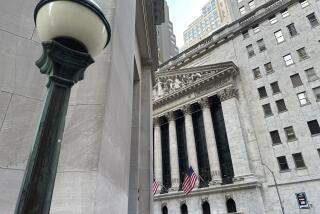STOCKS : Interest Rate Fears Pull Dow Down 12.16
Prices slumped on Wall Street on Tuesday as the stock market, taking another cue from the bond market, succumbed to concerns about rising interest rates.
The Dow Jones index of 30 industrials fell 12.16 to 2,674.55.
In the broader market, declining issues outnumbered advancing issues in nationwide trading of New York Stock Exchange-listed stocks, with 557 up, 913 down and 498 unchanged.
Big Board volume rose to 145.44 million shares, up from Mondayâs 114.79 million.
The stock market began the day on the down side after bond prices fell in response to the Commerce Departmentâs report of a 0.9% drop in retail sales in February.
The sales drop was the steepest in four months, but analysts said it was due almost entirely to sagging automobiles sales. Other segments of consumer spending experienced healthy increases, they said.
The report was seen as a sign of economic health and as a signal that the Federal Reserve was unlikely to move interest rates lower any time soon.
Wall Street tried to shake off the news and the bond marketâs decline, but when Treasury prices fell further, stocks joined the selloff.
Stock traders were also uneasy about the rise in credit market yields, which affect other interest rates.
Concerns about interest rates have dominated Wall Street since the beginning of the year and forced stock traders to pay close attention to the credit markets.
The most actively traded issue on the NYSE was Unisys, up 1/2 to 15 5/8.
Among blue chip stocks, which had led the brief recovery, IBM was off 1 1/2 to 106 1/4, Exxon was down 7/8 to 45 5/8 and Philip Morris was off 3/8 to 37 5/8.
Selective airline stocks outperformed the market. AMR was up 1 3/8 to 64 7/8, Delta picked up 1 5/8 to 71 3/4 and UAL rose 3 3/8 to 139 7/8.
In London, stock prices finished slightly higher on Londonâs Stock Exchange. The Financial Times 100-share index rose 1.7 points to close at 2,224.5.
CREDIT Bond Prices Decline on Retail Sales News Bond prices were hammered by the Commerce Departmentâs retail sales report and by a weakening dollar.
The Treasuryâs closely watched 30-year bond dropped 1 1/16 points, or more than $10 for every $1,000 in face value. Its yield, which rises when the price falls, soared to 8.71% from 8.61% late Monday, its highest level since last spring.
The yield on the key bond hasnât traded that high since May 19, 1989, when it also reached 8.71%.
âThe (bond) market focused more on the non-auto data,â said Elizabeth G. Reiners, a vice president at Dean Witter Reynolds Inc.
Signs of strong consumer spending and a robust economy tend to reduce the chances that the Federal Reserve would encourage lower interest rates. Retail sales represent about one-third of the nationâs economic activity.
Analysts said bond prices weakened in the morning when the retail sales report was released and were hit again when the dollar reversed its gains against other major currencies.
âThe market seemed to really fall apart around 12 oâclock,â said Peter Greenbaum, an economist at Smith Barney, Harris Upham & Co.
The dollar fell over concern about a plan for German monetary unification. A weaker U.S. currency tends to drive down bond prices by reducing the value of dollar-denominated investments held by overseas investors.
The federal funds rate, the interest rate banks charge each other on overnight loans, was quoted at 8.188%, unchanged from Monday.
COMMODITIES Stronger Dollar Sends Gold Lower Gold futures dropped again and analysts said the price could fall to $385 an ounce before enough buyers surface to offset the negative effects of the strengthening dollar.
On other commodity markets, silver futures rose; copper plunged; coffee and cocoa futures surged; grains and soybeans slumped; cattle futures gained; pork futures retreated, and energy futures were mixed.
Gold futures settled 40 cents lower to 50 cents higher on New Yorkâs Commodity Exchange, with the contract for delivery in April down 40 cents at $400.70 an ounce.
Silver futures finished 1.5 to 1.7 cents higher with March at $5.059 an ounce.
April gold traded as low as $396.70, a four-month low, during the session but bounced back shortly before the close as the stock market and the dollar weakened.
Analysts said the dollarâs strength has become the dominant factor in the declining gold market, which traded near $430 for April delivery as recently as Feb. 7.
Copper futures plunged on the Comex late in the session as the stock market retreated. The copper market had been quiet for most of the day amid uneasiness about a strike that began Monday at the Southern Peru Copper Corp.
Copper futures settled 1.5 to 2.3 cents lower, with March at $1.19 a pound.
Coffee and cocoa futures rose sharply on New Yorkâs Coffee, Sugar & Cocoa Exchange amid fears of supply disruptions due to political unrest in the Ivory Coast, a major exporter of both commodities.
More to Read
Inside the business of entertainment
The Wide Shot brings you news, analysis and insights on everything from streaming wars to production â and what it all means for the future.
You may occasionally receive promotional content from the Los Angeles Times.










